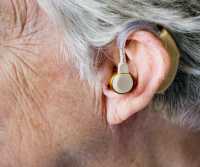
24 May NIH Spends Relatively Little on Hearing Loss
MedicalResearch.com Interview with:
Jan Blustein, MD PhD
Professor of Health Policy and Medicine
Wagner Graduate School and School of Medicine
New York University, New York
MedicalResearch.com: What is the background for this study?
Response: The National Institutes of Health (NIH), the nation’s largest public funder of health research, provides annual reports about levels of funding for many diseases and conditions. These reports, issued as part of the NIH’s Research, Condition and Disease Categorization (RCDC) process, allow members of the public to track funding across key conditions and across time.
Hearing loss is not included among the reported conditions. This runs counter to two of the NIH’s stated goals, according to researcher Jan Blustein (M.D., Ph.D.), professor of health policy and medicine at New York University’s Robert F. Wagner Graduate School of Public Service, in a Research Letter in the May 15th issue of the Journal of the American Medical Association Otolaryngology and Head & Neck Surgery.
“First, the NIH is committed to transparency about how it divides funds across diseases and conditions,” said Dr. Blustein. “Second, it has said that it will prioritize its funding to those conditions that cause the greatest disease burden.” Hearing loss causes great disease burden, ranking 10th in the U.S. among all conditions as a contributor to Disability Adjusted Life Years (a widely-used measure of disease burden), according to the World Health Organization.
MedicalResearch.com: What are the main findings?
Response: To determine annual NIH spending on hearing loss research, Blustein consulted a publicly available database. She found that spending in 2017 was $202 million. She then compared that level of funding with funding reported under the RCDC process for 29 other common diseases and conditions. Her analysis found that spending on hearing loss was low relative to disease burden, compared to the other 29 common diseases and conditions.
MedicalResearch.com: What should readers take away from your report?
Response: “I would expect the NIH to report every year regarding funding on a condition as pervasive, disabling and potentially preventable as hearing loss. Providing the public with reports on hearing loss spending through the RCDC system would allow us to readily track whether hearing loss is getting the research funding it deserves,” said Blustein.
MedicalResearch.com: What recommendations do you have for future research as a result of this work?
Response: NIH should consider tracking and publicly reporting on its level of funding for hearing loss research, as part of the RDC practice.
Citation:
[wysija_form id=”3″]
[last-modified]
The information on MedicalResearch.com is provided for educational purposes only, and is in no way intended to diagnose, cure, or treat any medical or other condition. Always seek the advice of your physician or other qualified health and ask your doctor any questions you may have regarding a medical condition. In addition to all other limitations and disclaimers in this agreement, service provider and its third party providers disclaim any liability or loss in connection with the content provided on this website.
Last Updated on May 24, 2019 by Marie Benz MD FAAD

